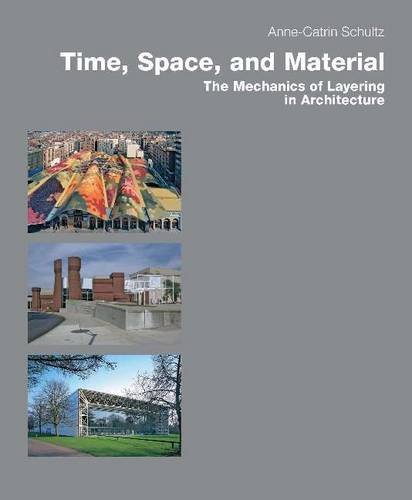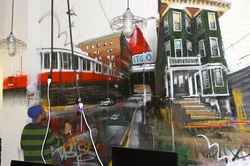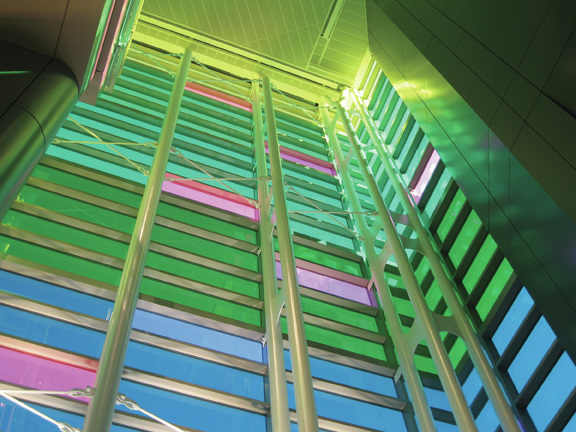|
On a field trip to the Diablo Glass workshop the senior and graduate students of my ARTitecture seminar at Wentworth Institute of Technology studied glass making techniques––both hot and cold glass processes. Glass studio co-founder Sean Clarke demonstrated glassblowing while Sheila Checkoway presented a workshop on glass bead making. Additional information on Wentworth at https://www.wit.edu and on Diablo Glass at http://www.diabloglassschool.com.
0 Comments
Art in the Landscape by Patrick Dougherty, Roxy Paine and Konstantin Dimopoulos
Christina Lanzl, PhD Life on earth is hard to imagine without trees. Their environmental, biological, economic and cultural functions permeate our existence. Countries that lack trees tend to subsist at the edge of survival. Three leading, contemporary artists from the U.S. and Australia––Patrick Dougherty, Roxy Paine and Konstantin Dimopoulos––have centered their creative inquiry on trees, creating temporary large-scale, site-based installations in the landscape that utilize trees. All three apply the strict modular principles of serial art.[1] How doe their works relate to the natural environment in terms of materials, narratives and interpretations? How do these artists’ installations differ from each other? Dougherty has been utilizing traditional basket weaving techniques to turn saplings into massive Stickwork environments that are architectural in nature (Ill. 1-4). Roxy Paine’s highly polished welded tree sculptures are naturalistic “structures in the realms of nature and industry”[2]. His Dendroids (Ill. 5-7) closely resemble leafless trees in a paralyzed, inanimate state. The term combines “dendron” (Greek for “tree”) and -oid (a suffix meaning “form”). Dimopoulos developed The Blue Trees (Ill. 8-10) environmental art installation, which has been realized in partnership with cultural and environmental organizations, cities and hundreds of volunteers at a dozen prominent sites worldwide. Stands of trees, either mature or saplings, are colored with an environmentally safe, ultramarine blue pigment to call attention to global deforestation. ORIGINS / SITINGS / SIGHTINGS Within the trajectory of art, culture and time, trees are closely linked to human existence. Ancient ritual embraced tree worship. They were depicted as part of the natural world in prehistoric art, such as the stick trees in the 25,000-year-old rock shelters of the Serra da Capivara in Brazil. In landscape painting, trees have been celebrated as subject matter since antiquity, when Greek and Roman artists created sculptures and murals prominently featuring gardens and trees. Landscape painting is highly regarded in Chinese art, where trees tower in visual expressions since the Northern Song Period beginning around 900 BCE. In Europe, trees emerged as a dominant subject in Dutch landscape paintings of the early 16th century. The notion of an intimate communion with nature commenced during the Romanticism of the 19th century, partly in reaction to the Industrial Revolution and a new scientific look at nature. Typically, the artist and the viewer both embrace aesthetic gratification and an emotional response. The representation of trees in art continues to change. In our own age of increasing environmental concerns a new consciousness regarding the fragility, even endangerment of nature is becoming ever more present, as demonstrated by Dimopoulos, Dougherty and Paine. Patrick Dougherty: Stickwork Art in the landscape has been a growing phenomenon, with site-specificity becoming an important consideration starting in the 1970s. North Carolina-based, Patrick Dougherty, has been creating his Stickwork since 1975, usually weaving local into his walkable structures built from saplings harvested nearby. He describes his method: Taking advantage of a new art trend of building sculptures on location, I began to work on-site for museums, artist-run spaces, sculpture parks, gardens, and private individuals. […] I initially exported saplings from North Carolina to other places, using a truck and trailer purchased with money from a North Carolina Arts Council artist fellowship. However, I quickly found that the typical cycle for urban expansion meant that I could find a supply of saplings in almost every community; that is, when forests are cut at the edge of town, the scrubby regrowth is available until the bulldozers arrive for final clearing.[3] To date, the artist has created over 250 Stickwork installations at sculpture gardens and in partnership with museums in the U.S. and abroad, immersed in his choice medium of tree saplings. What the Birds Know (Ill. 4), shown on the front lawn of the Peabody Essex Museum’s historic Crowninshield-Bentley House as the museum’s first major outdoor commission. The five structures are reminiscent of ”a little housing project”,[4] as described by Dougherty. Source of inspiration was a nearby small cobbler’s shed located between the historical John Ward House and a Quaker meetinghouse. Often, Patrick Dougherty harvests during the sequence of suburban real estate development. Pending availability at an installation location, he collects, where forests have been cleared for future construction. In Salem, he was invited to cut invasive species, such as Norway maple and buckthorn, in addition to cherry. Roxy Paine: Dendroids Roxy Paine has been welding full-size tree sculptures since 1998, after building art making machines and realist tableaus of Weed Choked Gardens (1998-2006) or, poisonous mushroom plantations (e.g. Amanita Muscaria Field, 2000). Paine’s sculptures exist at the intersection of nature and an artificial, man-made world, deepening his earlier artistic inquiry. Typically, he creates objects that either imitate nature or automate artistic production. In this regard, his approach differs from Dougherty and Dimopoulos, who use nature as a resource in their installations. Paine’s first large-scale outdoor works are the product of artist residences in Sweden (Impostor, 1998) and Spain, (Transplant, 2001). The Dendroids are hand-welded from thousands of pieces of industrial pipe, plate and rods. Tree mushrooms propagate along the shafts, furthering the notion of decay. Beginning with the Whitney Biennial’s invitation to install Bluff (2002) (Ill. 5), in Central Park,[5] the Dendroids have been highly acclaimed. Philadelphia’s Association for Public Art launched a one-year installation of Symbiosis (2011) on Benjamin Franklin Parkway on the open lawn of Iroquois Park in June 2014 (Ill. 6-7). In Symbiosis a second, smaller tree skeleton supports the weight of a giant, collapsed tree. Nature is dying in Roxy Paine’s leafless tree sculptures, a message for the viewer to ponder. These works lead to deep questions about the collision of nature and the manmade. Konstantin Dimopoulos: The Blue Trees Konstantin Dimopoulos developed The Blue Trees concept following his move from New Zealand to Melbourne, Australia, a city that promotes tree planting and takes pride in its tree canopy of already 20 percent. As an environmentalist, the artist is deeply concerned with the issue of global deforestation. This led to his first use of blue pigment, directly applied to the trunks and branches of mature trees in the installation, Sacred Grove – The Blue Forest, Afforestation Art Action at the Melbourne Cricket Ground in 2005 (Ill. 8). Dimopoulos chose the color blue because it is immediately recognizable: “Color is a powerful stimulant, a means of altering perception and defining space and time. The fact that blue is a color that is not naturally identified with trees suggests to the viewer that something unusual, something out of the ordinary has happened. It becomes a magical transformation.” His next invitation to realize The Blue Trees came from the Vancouver Biennale in 2011 (Ill. 9). There, he achieved a rich tapestry of effects over the course of spring, summer and fall at several sites. Since then, the Blue Trees have been realized at over a dozen venues in North America, Europe, Australia and New Zealand. Typically, Dimopoulos is commissioned by city agencies or cultural non-profits serving urban audiences. MATERIAL CHOICES: PERMANENCE AND EPHEMERALITY Choosing different materials leads to a distinctive narrative and inherent durability of the artwork. The sapling Stickwork and The Blue Trees colorant last for a limited period, rendering these installations a poetic blink in a nature setting. The Dendroids also have their place in temporary cultural programming, like the Whitney Biennial. However, due to the permanence of steel, these sculptures are not tied to landscape in the same way as Stickwork and The Blue Trees. Case in point: Symbiosis was acquired as a permanent sculpture through a grant from the Daniel W. Dietrich II Trust in January 2015.[6] Over time, Dougherty has become a master at weaving saplings. He has dedicated his entire art practice to perfecting his craft. In Dingwall, Scotland, he studied with the Scottish Basketmakers Circle to further perfect his craft when building the 22-foot high Close Ties (2006) (Ill. 2) from willow saplings: “[…] the real treasure, though, was the hardy band of basket makers who came from all over Scotland to help me work on the sapling sculpture. With them, they brought a deep appreciation for the material as well as tales of sticks, especially their own local varieties.”[7] As noted earlier, Dougherty’s constructions are generally inspired by the landscape that surrounds them. Ancient stone circles in Calanis inspired the artist to shape the work like primal stones. Picking up on the idea of ritual and celebration at the ancient sites, Close Ties was burned at a festival following the spring of its making.[8] Unlike Dougherty’s Stickwork, The Blue Trees are just one aspect of the artist’s oeuvre. Besides working in the genre of temporary installation, Dimopoulos also is a recognized sculptor who has sited his Linear Sculptures commissions in urban as well as landscape settings, such as Wheatfield With Crows (2014) at the Meadows Community Recreation Centre in Edmonton, Canada (Ill. 10). These kinetic works of reinforced fiberglass and carbon fiber in densely arranged grids, are activated by the wind. His oeuvre ranges from public art and sculpture to environmental installations on topics concerning the state of humanity. TERMS OF ENGAGEMENT Both Dimopoulos and Dougherty usually recruit dozens of local volunteers for the creation of their works. This approach corresponds with the project partners’ objective to involve audiences and communities. Civic engagement and interactivity indeed are more and more important to cultural production. The PEM installation involved a group of 50 volunteers in the sapling construction. In this regard, Dougherty works like Konstantin Dimopoulos who actively engages volunteers to assist with applying blue pigment to trees that washes off in the course of several months. Engaging locals in the production is a key strategy by Dimopoulos to bring his environmental message to the public in a grassroots effort that is also shared via the press and media. In contrast, the production of Roxy Paine’s Dendroids requires professional skills and equipment that limits general volunteer and community engagement. CONCLUSION Within the last 50 years, the installation and traditional interpretation of art and sculpture in the landscape has dramatically changed. While reverence or awe of nature continues to be an important aspect of art in natural surroundings, particularly in sculpture park settings, some contemporary artists, such as Konstantin Dimopoulos and Roxy Paine raise consciousness of the fragility and devastation of nature. They do so in a highly refined, aesthetic manner, while utilizing the site as a means to comment on declining environmental conditions, both naturally occurring and caused by humanity. Working with pigment, natural material and refined steel, Dimopoulos, Dougherty and Paine have been attracted by trees, thus continuing the long trajectory of humankind’s symbiotic relationship with them. Notes [1] Repetition was introduced into the modern art canon by artists like Joseph Albers, whose square paintings of the Homage to the Square series (1950-1976) became single, repeating images in variations, a theme further developed in minimalism. [2] Eleanor Heartney. Roxy Paine. New York: Prestel. 2009, p. 14-15. [3] Patrick Dougherty. Stickwork. New York: Princeton Architectural Press, 2010, p. 17. [4] Will Broaddus. “Stick Work: Artist invites public to watch as he builds sculptures in Salem.” Salem News, 5.13.2015. www.salemnews.com/news/lifestyles/stick-work-artist-invites-public-to-watch-as-he-builds (Accessed 6.19.2016) [5] Also documented in a mongraph: Anne Wehr, ed. Bluff (New York: Public Art Fund, 2004). [6] See http://associationforpublicart.org/symbiosis (Accessed 6.19.2015) [7] Patrick Dougherty. Stickwork. New York: Princeton Architectural Press, 2010, p. 134. [8] Irina Vinnitskaya,. “Stickwork: Patrick Dougherty”. ArchDaily, 4.16.2012. www.archdaily.com/224561/stickwork-patrick-dougherty (Accessed 6.19.2015) Bibliography Konstantin Dimopoulos Lanzl, Christina. "Making a Mark: The Blue Trees Environmental Art Action." Public Art Review 52, Spring/Summer 2015. Scarlett, Ken. “Sinuous Colour.” Sculpture, May 2007, p. 44-47. Patrick Dougherty Broaddus, Will. “Stick Work: Artist invites public to watch as he builds sculptures in Salem.” Salem News, 5.13.2015. www.salemnews.com/news/lifestyles/stick-work-artist-invites-public-to-watch-as-he-builds (Accessed 6.19.2016) Dougherty, Patrick. Stickwork. New York: Princeton Architectural Press, 2010. Maunsell, Penelope; Dalsheimer, Kenny (dir.). Bending Sticks: The Sculpture of Patrick Dougherty. PenKen Productions, 2013. Vinnitskaya, Irina. “Stickwork: Patrick Dougherty”. Archdaily, 4.16.2012. http://www.archdaily.com/224561/stickwork‐patrick‐dougherty Roxy Paine Heartney, Eleanor. Roxy Paine. New York: Prestel, 2009. Wehr Anne (ed.). Bluff. New York: Public Art Fund, 2004.
The author presents a useful, interdisciplinary discourse on architecture understood as a continuous process based on the concept of layers. Clear definitions of layering in several scientific fields examining the physical environment are introduced and serve as structure of the entire book with chapters on:
• Temporal layering: sedimentation, additive or subtractive process over time; • Spatial Layering: simultaneous perception of spaces; and • Material Layering: additive configuration of planes. More recently, Schultz has expanded her scientific scope to include cultural placemaking, thus adding the dynamics of the immaterial, i.e. human memory and narrative, which inform the meaning of place. Laid out are layering processes in geology, archaeology, engineering, graphic design and the visual arts. The key to Schultz’s approach is an examination of sections beyond a structural or stylistic understanding, ultimately aimed at dissecting, analyzing, and folding a period, a city, or a structure into a system of data. In the literature the ‘monolith’ dominates up to the 18th century. A layered approach enters the conversation beginning in the 19th century. A thoughtful connection is made to visual artists intense experimentation with layering starting with modernism. Prominent examples showcased are early 20th century Cubism, developed by George Braque (and Pablo Picasso, though not mentioned) with collages of single objects that are defined through simultaneous, coexisting planar layers. In the 1960s and 1970s, Robert Smithson’s minimalist geometric forms introduce repetitive layering and serialization in this minimalist vocabulary, further developed by Gordon Matta Clark in his ‘building cuts’. The link to contemporary art is established by the large-scale installations of Japanese artist Nabuko Nakanishi, comprised of hundreds of successive images in his Layer Drawings. Also mentioned might be the infinite mirrored assemblages of Josiah McElheny. The phenomenon of layering in architecture is painted in broad strokes beginning with a review of Vitruvius, followed by insights on the temporal layering of important historic buildings through the centuries with their evolving architectural styles. A subchapter is dedicated to the important discovery of polychromy and its connection to textile design in Greek temples beginning around 1800. Outstanding recent, featured examples of layering include the Santa Catarina Market in Barcelona and the transformation of this former convent to a covered market by architects Enric Miralles and Benedetta Tagliabue who collaborated with artist Toni Comella on a dramatic colorful roof mosaic. A comparison of fifteen case studies in contemporary architecture that measure both the effective depth and the chronology of layering in building envelopes reveals surprising insights. The exteriors of notable designs by Foster + Partners, Morphosis, Sauerbruch Hutton and Peter Zumthor range in depth from over four up to eight feet. Others, such as Duiker, SANAA and SOM, designed walls of less than one foot in depth. Interestingly, it is revealed, intense layering clearly is a preferred architectural practice rather than an evolving trend.
The Fort Point Arts Community’s (FPAC) art lending program showcases artists from Boston's Fort Point and beyond. LogMeIn, a global company with headquarters in Fort Point, has been a strong ally of the arts and culture in the neighborhood. LogMeIn provides worldwide solutions for remote control, file sharing, systems management, data backup, business collaboration and on-demand customer support of PCs, servers, Macintosh computers, smartphones and other connected devices. FPAC offers an art-lending program, art commissioning and corporate art consulting services. Working together benefits the partners and strengthens the arts and culture in Fort Point, a neighborhood on South Boston’s waterfront. FPAC is committed to working with clients and artists so that specific needs and expectations are being met. Investing in art, culture and Boston artists improves the quality of life in your surroundings, creates sense of place and identity and stimulates growth. Services are provided on a fee-based structures tailored to individual budgets and requests. Participating artists benefit through art loan honorariums and art commissions. Christina Lanzl manages the program as FPAC Project Director since July 2015, working hand-in-hand with Executive Director Emily O'Neil and the FPAC Board of Directors, chaired by Jen Mecca.
The third long-term exhibition at LogMeIn features works by Emily Cobb, Monica Chiang, Nathan Evans, Ian Kennelly, Sterling Mulbry, Kimberly Radochia, Claudia Ravaschiere and Jonathan Stark. On August 18, LogMeIn celebrated the installation of six works by Elisa Hamilton, Dylan Hurwitz, Karen McFeaters, Andrew Neumann, Krina Patel and Tom Wojciechowski. The works highlight LogMeIn’s truism “Possibility Increases with Connectivity”. The group of place-specific commissions were the result of an open FPAC call for artists in fall 2014. LogMeIn's Simply Possible, a corporate identity project. The success of this first initiative at LogMeIn's world headquarters in Boston is now introduced to their offices around the world, as well. PRESS Nick DeLuca. "LogMeIn Marks Fort Point Expansion By Showing Off Neighborhood Artists." BostInno, August 19, 2015. "LogMeIn Enlists Art Community to Help Re-launch Brand." nasdaq.com, August 18, 2015. Simply Possible Artist Statements 1. Elisa H. Hamilton Simply Possible Crayon, ink, gouache, and oil pastel on paper. 48 pieces, 7" x 7" each The art that I make is grounded in the belief that we are constantly surrounded by reasons to be joyful. I strive to bring the inherent brilliance of our everyday places, objects, and experiences into vivid focus. I work from life, captivated by the honest vibrancy of our ordinary surroundings. I explore everyday subject matter with ordinary materials such as crayon, ink and paper- heightening what may be considered commonplace with multi-layered works that revel in color, texture, depth and shape. The subject matter I choose speaks not only to our day to day surroundings, but also to our broader human experience; relationships, expectation, triumph, loss- but above all, hope. 2. Dylan Hurwitz untitled (Fort Point 2015) Oil and acrylic on canvas 48” x 60” untitled (Fort Point 2015) is the result of a collaboration between a group of LogMeIn employees and artist Dylan Hurwitz, where the artist performed on piano while LogMeIn employees danced on a canvas stage with paint. The piece is part of a larger project of Hurwitz's that utilizes music and dance to create paintings. As a trained pianist and painter, Hurwitz's work is often the result of an attempt to bridge both practices. 3. Karen McFeaters Full Spectrum Triptych Acrylic on canvas 24” x 72" (three 24 x 30" canvases) Full Spectrum Triptych is my depiction of the way business has been conducted over the years, past and present. The first of the three paintings is monochromatic, representing an antiquated model of doing business when people where anchored to large buildings to get things done. The center painting introduces more color as the bridge between the "new" buildings and the "old," as well as the connection between the old way of doing things and the new. The third painting is the brightest and most colorful of the three canvases, depicting Fort Point, home of the original innovators (the artists) and now also the home of innovators in technology, such as LogMeIn. A neighborhood rich in history and ripe with potential, I'm proud to call it my home. 4. Andrew Neumann Crane (matrix) digital ink jet print, solid-state media player, video module 48" x 36"x 6" Crane (matrix) is a meditation on construction cranes, all shot out one specific window in my studio in Fort Point. Documented over an 18-month span, the piece depicts different weather patterns, and is constructed as a matrix of still video images juxtaposed against a single video screen, contrasting the "static" versus the "dynamic". 5. Krina Patel Simply Connect Wood approx. 70" x 48" x 8” Simply Connect is a fun interactive piece that evokes childhood memories while referring to LogMeIn's work of enabling people to simply connect. The motif on the game pieces is inspired by Hungarian embroidery acknowledging the company's early connection to Hungary. 6. Tom Wojciechowski Simply Possible Photographs 20” x 72” This piece is part of my series titled Writing with a Camera, where a stationary light source becomes the writing utensil of a moving camera. The project is a singular fit for LogMeIn's tag line. Using the headquarter building's sign and a neighborhood streetlamp, I spell out the words in dynamic fashion. |
Urban Culture Institute
The Urban Culture Institute Archives
May 2021
Categories
All
|
- Home
-
Projects
- Worcester
- Howes Park
- Coppens Square Park
- Codman Square Park
- Gourdin Park
- Kulturpark Berlin
- TEMPOart
- Ringer Park
- Mather School Green Space
- MBTA Red Line Wollaston Station
- MBTA Silver Line Extension
- Boston Children's Hospital
- HarborArts Boston
- Social Muscle Club
- Memphis Art Walk
- To Extremes
- Art in Architecture Study
-
BSA Placemaking Network
>
- 2019 Placemaking Seminars
- 2018 Placemaking Seminars
- 2017 Placemaking Seminar Series
- Placemaking Seminar Series 2016
- Placemaking Seminar Series 2015
- Placemaking Seminar Series 2012
- Placemaking Seminar Series 2011
- Placemaking Seminar Series 2010
- Placemaking Seminar Series 2009
- Placemaking Seminar Series 2008
- Blog
- Publications
- Team
- Maps
Proudly powered by Weebly




 RSS Feed
RSS Feed